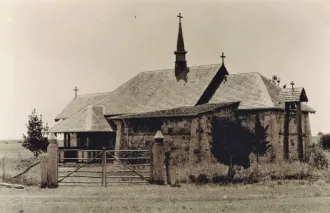St Peter’s Church. St Peter’s Church. St Peter’s Church. St Peter’s Church. St Peter’s Church. St Peter’s Church. St Peter’s Church. St Peter’s Church. St Peter’s Church.
St Peter’s Church – Badgebup
Compiled by Doreen Clegg, November 1986
St. Peter’s Church, Badgebup was built as a memorial to Private John Campbell Dale Warren, eldest son of J.C. and Lillie Warren of “Dyliabing” and other boys of the district killed in action in the First World War 1914-1918. These were early days of settlement in the district, the Warren family having taken up land in 1898, and Campbell’s parents thought that a district church would be a fitting memorial to their son.
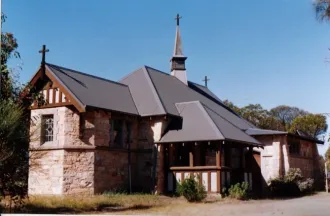
St Peter’s Church, Badgebup
The project received great support and, in 1919, Mr. R.L. Richardson donated an acre (one thousand square metres) of land for the Church. He owned the paddock and nearby General Store.
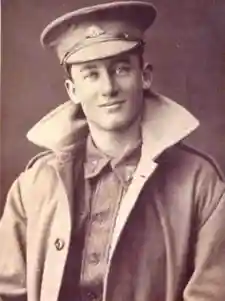
Private John Campbell Dale Warren
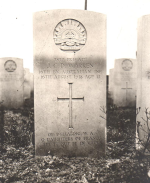
1918 Grave stone of John Campbell Dale Warren of 16th battalion A.I.F died in action at Guillancourt, 16th August, 1918, aged 21 and buried at the Heath Cemetery Harbonnieres, France.
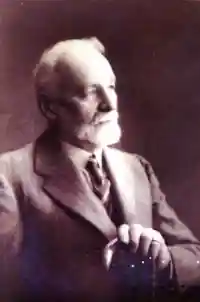
John Campbell Warren Snr
Quarrying of the soap stone began on “Dyliabing” (11 kms north of Badgebup) on the 31st May, 1919. In July a working bee was held fencing two sides of the block and planting ornamental trees.
On October 25th that year Mr. Herbert Eales of the architects, Messrs. Eales and Cohen of Perth, came to inspect the site. He was also a talented musician and on that occasion a social was held to raise funds for the Church and he played the piano.
Mr. J. C. Warren and his son Gilbert continued to quarry the stone in their spare time, using dynamite to get the stone out. The architects estimated that 218 cubic yards (155 cubic metres) net of stone was required as apparently only 18 cu.ft. of useful stone was in one yard (or only 66% of one metre) of ordinary quarried stone. On the 28th January, 1920 the quarrying of stone began regularly and on February 20th the first trolley of stone (1/2 tonnes) was carted.
On June 22nd, 1920, Messrs. Eales and Cohen visited to choose a site on the block for the Church and they planted a tree on each side of the gate. Mr. Cohen was, in fact, a returned soldier and both men took a particular interest in St Peter’s Church and later wrote “we have taken a great Interest in the little Church and have never looked upon it as a business proposition.”
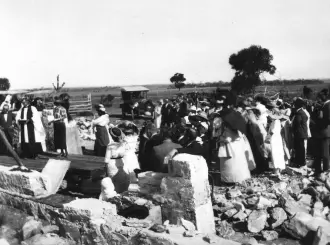
1922 Campbell’s mother Mrs John Campbell Warren (nee Lillie Dale) laying the Foundation Stone for St Peters church – see arrow.
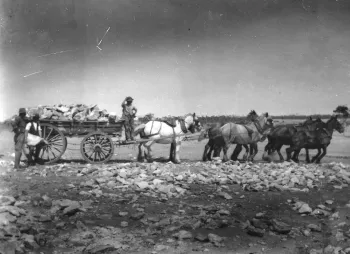
1920 Members of the Warren family and Badgebup community members carting stone from the Warren farm, “Dyliabing”. to build St Peters Church, Badgebup
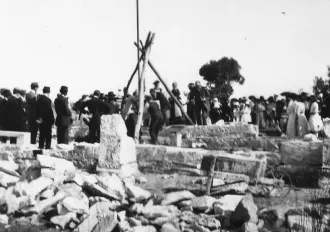
Laying of the Foundation Stone for the church 29th December, 1921
Carting of the stone began in earnest on 12th February, 1921, and the local settlers (of all denominations) rallied around and gave freely of their time by helping the Warren family cart the stone in their wagons and teams of horses. A sled on greased rails was constructed so that the cart horse could pull the stone out of the quarry and on to the wagons.
Building commenced on the 28th December, 1921, but prior to this a shed was built on the site. Sand and water also had to be carted and this was mainly done by Gilbert Warren. The lime for the mortar came from a deposit on Mr. E.A. Clegg’s property, a few miles south of the Church, and this was carted by Mr. Clegg and his two sons. The stonemasons were Mr. George Thorpe, who had lost two sons in the War, and his nephew Mr. Wright. Mr. H.A. Groth of Leederville was engaged to build the furniture and the carpenters were Mr. Tom Berry and his brother Cyril, both ex-soldiers.
Donations for the furniture and furnishings came from many quarters; including the Warren family in Western Australia and South Australia, friends and neighbours, Sisters Vera and Rosalie of Perth College (where Campbell’s sisters had completed their education), Dr. Wilson Bishop of Bunbury and Archdeacon and Mrs. Burbidge.
The Church was named “St Peter’s” after St Peter’s College, Adelaide, South Australia where Mr. Warren and his sons were educated. On the 29th December, 1921, Canon (later Archdeacon) Burbidge of Katanning laid the very first flat foundation stone for the base of the buttress on the N.E. corner of the chancel. On the 4th February, 1922, came the official laying of the foundation stone. This was carried out by Mrs. J.C. Warren in the presence of Bishop Cecil Wilson of Bunbury, Archdeacon Burbidge of Katanning, local residents and visitors. The stone is inscribed TO THE GLORY OF GOD.
There is a jade stone {which has since been stolen) built in the wall above the foundation stone which came from the Warren’s old family farm “Springfield” in South Australia (45kms north-east of Adelaide). This was such a proud occasion for the district that Mr. Bob Turner loaned his large Union Jack which was run to the top of the pole for the laying of the stone. Mr. Eales also took part by accompanying the singing on the organ.
In April, 1922, before the Church had a roof, the first christening took place. The baby was Barbara, daughter of Mr. and Mrs. Ted Goodchild. On Saturday, 16th September, 1922, the consecration was performed by His Grace the Archbishop of Perth, C.D.L. Riley (as Bishop Wilson of Bunbury was ill) and the Archbishop also planted a tree.
The next day a Choral Communion Service was held for which Mr. E.A. Clegg Snr. had written the music. A choir of local men and women was formed and led by Mr. Clegg who was the organist of the Church until he retired to live at Emu Point in 1939 when Mrs. Laurie Caldwell took over.
The first wedding at St Peter’s was solomnised on the 11th September, 1923 when Margaret (Meg) Warren married Ernest Clegg.
On Saturday, 27th October, 1923, the Governor Sir Francis Newdegate and Lady Newdegate visited St Peter’s. They were on a train going through to Pingrup for the official opening of the railway. Special arrangements were made to stop the train at Badgebup so that they could pay a special visit to the Church. A large crowd of people turned out to meet them and watch Sir Francis plant a pine tree.
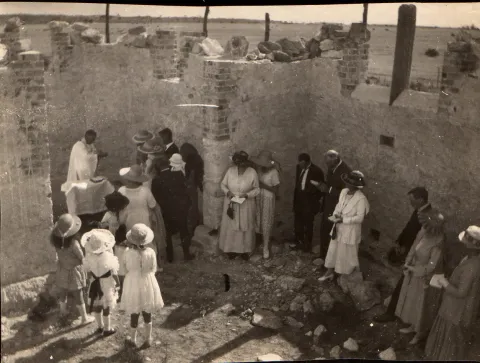
1922 – First christening
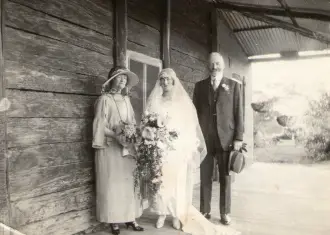
1923 – First wedding
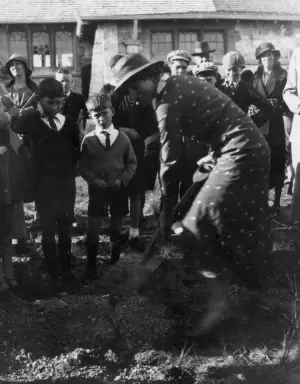
Lady Hankey, planting a tree at St Peters Church Badgebup. She was the wife of Sir Maurice Hankey from England, who was a cousin of J.C. Warren, Campbell’s Father.
Another important visitor was Sir Maurice Hankey. Sir Maurice was an English relative of J.C. Warren and, while visiting Australia on matters of defense in 1934, he attended a service. Afterwards he and Lady Hankey planted red flowering gums, but only Sir Maurice’s survived and still stands today. Memorials to the Hankey family are to be found in the Church.
Points of interest in the church
The roof was originally she-oak shingles but was later replaced by tiles. The porch is considered unique and it is interesting to see the Architects designed this porch with a roof and seats “for rest and shade”.
The belfry was erected after the completion of the Church. The bell was given in memory of J.C. Warren’s cousin, John Warren Bakewell, by his wife. The bell was made by Messrs. Gillett and Johnstone of Croydon, England in 1924. Before it arrived Mr. Warren wrote to the Minister for Trade and Customs asking if the bell could be admitted duty free, explaining what it was for, and the reply below came back and duty had to be paid!
Melbourne
9th July, 1924.
Dear Sir,
I have to acknowledge receipt of your letter of the 271h June, 1924, In which a request was made for admission free of duty for a bell for St Peter’s Church, Badgebup, W.A. and I desire to inform you that it is regretted that there is no item in the Tariff under which the request could be acceded to.
The tariff provides for admission free under item 417(b) of articles donated to the public or a public institution, but the legal advisers of the Commonwealth have held that articles donated to a Church cannot be brought within the item.
Yours faithfully,
(sgd) H. E. PRATTEN
MINISTER FOR TRADE AND CUSTOMS
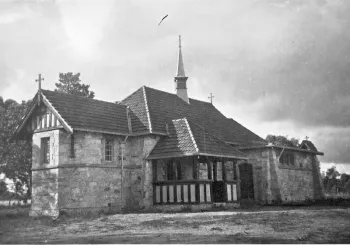
St Peter’s Church c1930
Conclusion
Since the early days, additional work and maintenance has been carried out, notably the altar frontal was made by Mrs. R. E. Tree in 1959. The ornamental gates were made in May, 1960, by local farmers Gordon Ohrt and George Goodchild. Following the death of J. C. Warren in 1947, his son Gilbert took over as Secretary of the St. Peter’s Committee and later served on the vestry of St. Andrew’s representing St. Peter’s until his death in 1973.
On the 17th September, 1972, a Golden Jubilee Service was held. This was conducted by the Rt. Revd. Warwick Bastian, Bishop of Bunbury, assisted by the Revd. Michael Harford who was rector in Katanning at that time. This was followed by a large gathering of Badgebup and district residents, former residents and old friends, in the Hall.
Similarly, on the 9th June, 1982, a service was held to mark the Diamond (60th) Anniversary of the Church. This was held appropriately on Pioneer Day of W.A. Week. Later, at afternoon tea in the Hall, Mrs. Cicely Blackall (nee Warren) and Mr. Angus Caldwell (son of Oliver Caldwell) gave talks and reminiscences on the building of the Church, etc.
It has been said that a memorial is not a dead thing but a living presence in the Community. This is true of St Peter’s Church. An Anglican service is conducted once a month for the Badgebup and Nyabing district and, from time to time, weddings and baptisms take place. Annually the Badgebup/Rockwell Red Cross Unit organise an interdenominational service in St Peter’s. Other denominations have had the use of the Church and in the 1960’s, regular services were held by Methodists and Presbyterians. This was, of course, the hope of J.C. Warren – that St Peter’s would be a Church for the whole community.
July, 2007 – Addendum
The historic value of St. Peter’s Church was recognised in January, 1996, when it was added to the official Heritage List of Western Australia. By this time a great deal of restoration work was needed. Possums were getting through loose tiles in the roof and damaging the ceiling. The walls were also badly cracked.
In February, 1996, a Restoration Committee was formed, made up of five Badgebup residents. Application was later made for a Grant through the National State Grants Programme. An initial Grant of $2,000 was received to pay for the services of a Structural Engineer Mr. Ralph Unger of Albany. After inspection he pinpointed the necessary work and agreed it should proceed. The Heritage council then allocated a Grant of $17,000 in September, 1998, which would include the work of an Architect Mr. David Heaver of Albany. He approved the work and suggested the main item; a colourbond roof.
A fundraising campaign followed as the cost would exceed the Grant. This was a great success with the generosity of local residents, past residents, families and interested people. Katanning builder Mr. Alan Julian was employed to replace the roof and this work was completed in April, 1999. In April, 2001, Katanning builder Mr. Dominic Schiano filled in and plastered the cracked walls and, in April, 2001, Constant Ceilings Ltd. replaced the possum damaged ceilings. In September, 2001, local couple Nick and Cecily Richardson volunteered to paint the Church prior to their marriage.
The efforts of so many people proved to be worthwhile as St. Peter’s had been resorted to its former state. The notice board and a new fence was the result of a Grant from the Centenary of Federation Project 2001.
An unfortunate incident happened in July, 2002, when the jade stone from “Springfield” S.A. next to the foundation stone was stolen. The stone has not been recovered or the culprit found. In December, 2004, a bushfire destroyed a large area of Badgebup. The fire raged through the Churchyard destroying fences and trees. Through prompt action from Volunteer Firemen the church was saved and stands today –
A Church in the Bush for use of the Community.
